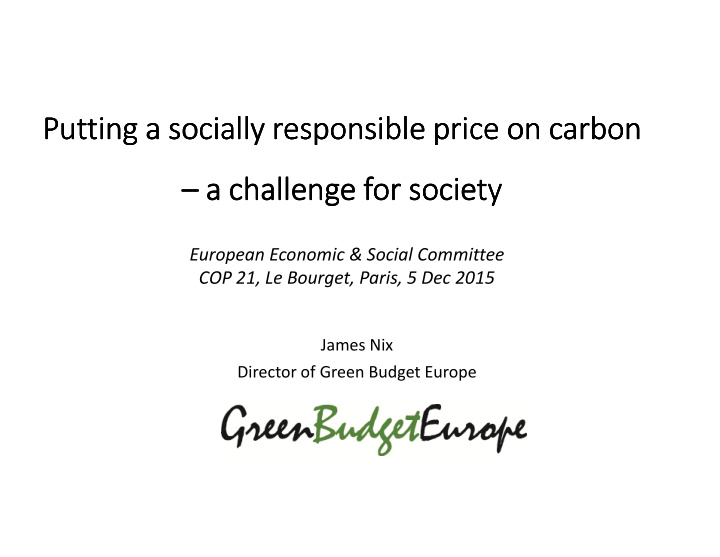



Putting a socially responsible price on carbon Putting a socially responsible price on carbon Putting a socially responsible price on carbon Putting a socially responsible price on carbon – a challenge for society – a challenge for society – – a challenge for society a challenge for society European Economic & Social Committee COP 21, Le Bourget, Paris, 5 Dec 2015 James Nix Director of Green Budget Europe
Two concepts: To fund climate finance: Aviation levy To reduce emissions: Carbon fee & dividend
Regional CO2e emissions Regional CO2e emissions – – per capita averages per capita averages Regional CO2e emissions Regional CO2e emissions – – per capita averages per capita averages Source: Chancel & Piketty (2015) using estimates based on CAIT (WRI 2015), CDIAC (Boden et al. 2015) and Maddison (2013)
Top 10% of CO2e Top 10% of CO2e Top 10% of CO2e Top 10% of CO2e emitters emitters emitters emitters (45% of world (45% of world (45% of world (45% of world emissions) emissions) emissions) emissions) Source: Chancel and Piketty 2015
Middle 40% of Middle 40% of Middle 40% of Middle 40% of CO2e CO2e CO2e CO2e emitters emitters emitters emitters (42% of world emissions) (42% of world emissions) (42% of world emissions) (42% of world emissions) Source: Chancel and Piketty 2015
Bottom 50% of Bottom 50% of Bottom 50% of Bottom 50% of CO2e CO2e emitters CO2e CO2e emitters emitters emitters (13% of world (13% of world (13% of world (13% of world emissions) emissions) emissions) emissions) Source: Chancel and Piketty 2015
Raising climate finance from the rich – wherever they live “it is crucial to focus on high individual emitters rather than high emitting countries” “within-country inequality in CO2e emissions matters more and more” “regardless of where people live, individuals emitting similar amounts of CO2e should contribute to CO2e emissions reductions in the same way” - Chancel & Piketty (2015)
Air travel: a good marker of high emissions “Air transport … is generally associated with high living standards – at the world level at least – and it generally also operates a distinction between different income or social groups with the economy/first and business class system” “A global tax on air transport could thus have two interesting properties: it would reach high-income individuals and high emitters” Chancel & Piketty therefore propose an aviation levy averaging €20 per economy flight and €180 for business class flights Applying to all flights globally, the total would be c. €150 bn
Fee & Dividend: how does it work? • A carbon fee is placed on all GHGs and the money raised is given back to citizens in equal shares • Countries / trading blocs that adopt it impose a border tax which encourages others to join • Other than the operating cost, no funds are taken by governments from the fee: it all goes back to citizens Worked example: the EU emits c. 4.5 bn tonnes of GHGs. A carbon fee of €30 per tonne raises about €135 billion annually. Re-allocated to the EU’s 500m citizens, €270 is returned per person annually (€620 per average home p.a.)
Social equity: lower-income households spend far less on energy – and so have “dividend” money left over to save or spend
A forerunner: Iran’s fossil fuel subsidy reform where its Gov set up bank accounts to compensate the poorest 80% of citizens for energy price rises
Questions? Thank you director@green-budget.eu
Recommend
More recommend